
 |
| Obentoo is a boxed meal that can be taken anywhere, be it school, work, excursions, train trips, sports meets or cherry blosssom viewing. Obentoo come in all kinds : they are made at home, ordered out and delivered, bought at the bentoo store, eaten at a restaurant. They are usually eaten for lunch, but they can also make a satisfying meal if you are doing overtime at the office. At home, making the obentoo is a morning task that usually falls to the mother or wife, who packs them for her husband and children to take to work and schools. Rice, Japan's staple food, generally accounts for a large portion of each obentoo : okazu, or side dishes, are added to suit personal taste or nutritional needs. Okazu are often made of fresh, colorful, in-season ingreduents, arranged appetizingly in the bentoo box. An economical and practical answer to lunch, obentoo do not require refrigeration, and taste delicious even after they have cooled off. |
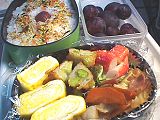  |
| History Before the Edo Period ( 1600-1868 ), obentoo was the purview of travelers and outdoor laborers. Their simple lunches consisted of dried rice, rice balls, or a sweet potato wrapped in leaves or bamboo sheaths. The much more elaborate makunouchi bentoo, eaten during intermission at performance of kabuki plays, made its first appearance in the Edo Period. It was also during this period that obentoo began to diverge from its functional roots, and it became the riguer to bring extravagant meals packed in layered, lacquered boxes on excursion. This typically Japanese approach to food -- making it so delicious-looking you could eat it with your eyes -- has carried over to the sumptuous obentoo that are served today in high-class Japanese restaurants. In the Meiji Period ( 1868-1912 ), ekiben, or obentoo that can be bought at the railway station ( eki ), become popular. Nowadays, obentoo are sold everywhere, from convenience stores to the best Japanese restaurants. In this issue, we look at three kinds of obentoo : the basic rice ball ( onigiri ), the deluxe makunouchi bentoo, and that must-have on a train trip, the ekiben. |
Onigiri  The word onigiri, meaning rice ball, comes from nigiru, a verb meaning to grasp or grip. In the Heian Period ( 794 - 1192 ), onigiri were known as tonjiki, or soldier's meal, because they were eaten on the go by memberes of the military. They are also called omusubi, ( from musubu, a verb meaning to tie ) and nigirimeshi ( meshi means rice ). To make onigiri, rice is shaped by hand into round, triangle or cylindrical shapes; in the center of each is umeboshi ( pickled plum ), tsukudani ( food stewed in soy sauce ), salmon, katsuobushi ( dried bonito ) or some other filling. The ball of rice is lightly salted; usually it is wrapped in nori ( dried seaweed ), but it can also be sprinkled with sesame seeds. |
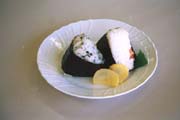  |
| Made from Japan's staple food, onigiri are easy to carry, and they keep for a long time. Japanese rice is sticky, so forming a ball of rice that holds its shape is no problem. The rice is compressed into a ball while it is still hot; the addition of salt helps presece onigiri, and an umeboshi filling acts as a anti-bacterial. Tuna salad and other unusual filling are a relatively recent invention, giving onigiri an intercultural flavor. | |
Makunouchi 
The makunouchi bentoo emerged in the Edo Period in Edo ( now Tokyo ) as the meal of choice during intermission at the kabuki theater ( the word " makunouchi " means the interval between acts ). Makunouchiis now a standard type of obentoo available at train stations, bentoo shops almost anywhere else. The rice is shaped into little cylinders and sprinkled with sesame seeds. Tamagoyaki ( sweet omelet ) is typically included, as is grilled fish, kamaboko ( boiled fish paste ) and many other kinds of foods. |
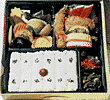  |
Ekiben  It is generally held that the first ekiben was sold in 1885 at Utsunomiya Station ( Tochigi Prefecture) : it consisted of onigiri and tsukemono ( pickles ). In Japan, where the railway system was faster to develop than dependence on private vehicles, ekiben, which featured local specialties, become a pleasure part of long train of Shinkansen. Department stores also put on ekiben fairs at which one can buy specialities from all over the country. Ekiben are packed with regional dishes of the area in which the station is located, and sometimes even the box it comes in reflects the taste or history of the locality in which it was made. |
| Obentoo Inside and Out | |||
| Inside : | |||
 |
 |
 |
 |
 |
 |
 |
 |
| Tamagoyaki : | Sausage Octopus , | Apple rabbit : | Sandwich : |
| Best-loved | Mom's creations are fun for kids | Not all obentoo are made of rice | |
Outside: | |||
| A typical bentoo-bako ( lunch box ) : Microwaveable and spill-proof, with removable chopsticks built into the lid | |||
| Child's lunch box : Fun design for children | |||
| Bamboo : " Breathes " well. Nowadays real bamboo lunch boxes are very expensive, and most are made of plastic | |||
| Box Lunch Lingo | |||
Hinomaru Bentoo ( Rising Sun Bentoo ) :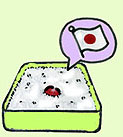 A rectangular box of white rice with an umeboshi in the center. A popular meal in the lean years before the war, hinomaru bentoo is hard to find nowadays. A rectangular box of white rice with an umeboshi in the center. A popular meal in the lean years before the war, hinomaru bentoo is hard to find nowadays. |
Hayaben ( Early Bentoo ) :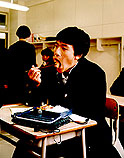 Hayaben are popular at high school, especially among boys, but you will never find them on sale in the store. Hayaben is a bentoo that you eat early ( hayai ) because you can't wait until lunch time. Hayaben are popular at high school, especially among boys, but you will never find them on sale in the store. Hayaben is a bentoo that you eat early ( hayai ) because you can't wait until lunch time. | ||
Aisai Bentoo ( Beloved Wife Bentoo ) :  A bentoo made for a husband by his wife. Makes your co-workers envious, but their good - natured razing might make you feel embrassed. A bentoo made for a husband by his wife. Makes your co-workers envious, but their good - natured razing might make you feel embrassed. |
Tebentoo ( Bentoo-in-hand ) : 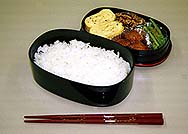 Originally meaning to bring your own lunch to work, it has come to mean working for free ( tebentoo de hataraku = to work on a volunteer basis ). Originally meaning to bring your own lunch to work, it has come to mean working for free ( tebentoo de hataraku = to work on a volunteer basis ). | ||
Hokaben ( Hot Bentoo ) : Originally a contraction refering to a bentoo chain store called Hoka Hoka Bentoo, hokaben now referes to any taleout obentoo. Hoka hoka means "piping hot." | |||
| Reference : | Maria Rodriguez del Alisal "Japanese Lunch Boxes" 1994 |
| Illustration : | Miya Soda |
Send feedback to forum@tjf.or.jp